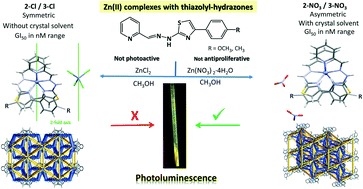Zn(ii) complexes with thiazolyl–hydrazones: structure, intermolecular interactions, photophysical properties, computational study and anticancer activity†
Abstract
Earth-abundant, cheap and non-toxic zinc-based coordination compounds are drawing research attention as promising candidates for various applications, such as photoluminescent materials and anticancer agents. In this paper we report six zinc complexes (1–3-NO3 and 1–3-Cl) with pyridyl-based thiazolyl–hydrazone ligands, which differ in the nature of substituents at the ligands' periphery, anion type, and geometry around the metal ion. The complexes were characterized by single-crystal and powder X-ray diffraction analysis, as well as IR and NMR spectroscopy. The symmetrical complexes 2-Cl and 3-Cl, where zinc atoms are located at a two-fold axis, do not exhibit photophysical properties, unlike their asymmetrical analogs 2-NO3 and 3-NO3 with the same complex cation. Asymmetrical pentacoordinated 1-Cl and hexacoordinated 1-NO3 complexes exhibit photophysical properties. An admixture of allowed intra-ligand (1IL) and chloro (X)-to-ligand charge-transfer (1XLCT) electronic transitions is responsible for the fluorescence of the 1-Cl complex. The origin of the emission of the 1-NO3 complex is ascribed to an admixture of 3IL and ligand-to-ligand charge-transfer (3LLCT) forbidden electronic transitions, while for 3-NO3 most electronic excitations are of LLCT character. The thermal stability of the complexes is in accord with the strength of respective intermolecular interactions. The antiproliferative activity of the complexes was in the nanomolar range on some of the investigated cancer cell lines. Contrary to the increase of antiproliferative activity of the complexes in comparison to the free ligands in cancer cell lines, an acute toxicity determined in the brine shrimp assay follows the opposite trend. The overall results suggest that Zn(II) thiazoyl–hydrazone complexes have considerable potential as multifunctional materials.



 Please wait while we load your content...
Please wait while we load your content...